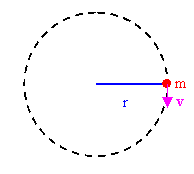 Solution:
Solution:An object moving in a circle of radius r with constant speed v is accelerating. The direction of its velocity vector is changing all the time, but the magnitude of the velocity vector stays constant. The acceleration vector cannot have a component in the direction of the velocity vector, since such a component would cause a change in speed. The acceleration vector must therefore be perpendicular to the velocity vector at any point on the circle. This acceleration is called radial acceleration or centripetal acceleration, and it points towards the center of the circle. The magnitude of the centripetal acceleration vector is ac = v2/r. (We skip the derivation of this expression.)
External link: Uniform circular Motion
The orbit of the moon around
the earth is approximately circular, with a mean radius of 3.85*108
m. It takes 27.3 days for the moon to complete one revolution around the
earth. Find
(a) the mean orbital speed of the moon and
(b) its centripetal acceleration.
Solution:
Summary: for an object moving on a curved path, the centripetal acceleration vector always points towards the center of curvature and its magnitude is v2/r, where r is the local speed and r is the local radius of curvature.
An object moving in a circle, either with uniform or non-uniform speed, is accelerating. Since it is accelerating, it must be acted on by a force. Such a force is called a centripetal force.
Let us solve some problems investigating this question.
A 3 kg mass attached to a light string rotates on a horizontal frictionless table. The radius of the circle is 0.8 m and the string can support a mass of 25 kg before breaking. What range of speeds can the mass have before the string breaks?
 Solution:
Solution:
A coin placed 30 cm from the center of a rotating, horizontal
turntable slips when its speed is 50 cm/s.
(a) What force provides the centripetal acceleration when coin is
stationary relative to the turntable?
(b) What is the coefficient of static friction between coin and
turntable?
Solution:
Do you feel yourself thrown to either side when you negotiate a curve that is ideally banked for your car's speed? What is the direction of the force exerted on you by the car seat?
Discuss this with your fellow students in the discussion forum!
For more information about uniform circular motion motion, study this material from "The Physics Classroom".
External link: Motion Characteristics for Circular Motion
External link: Applications of Circular Motion